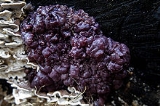
Exidia
Encyclopedia
Exidia is a genus
of fungi in the family Auriculariaceae
. Species are saprotrophic, growing on dead attached or recently fallen wood, and produce gelatinous basidiocarps (fruit bodies). The fruit bodies are variously pustular, lobed, button-shaped, or top-shaped. Several species, including the type species Exidia glandulosa
, have sterile pegs or pimples on their spore-bearing surface. Others are smooth. The genus has a cosmopolitan distribution and around 20 species are currently recognized worldwide. Initial molecular research indicates the genus is artificial.
along with many other gelatinous fungi. The genus Exidia was separated from Tremella by Fries
in 1822, based mainly on fruitbody shape. Fries initially included species now assigned to Auricularia
within the genus.
Recent molecular research has indicated that Exidia as currently circumscribed is an artificial grouping, species not being clearly differentiated from similar, but effused species assigned to the genera Exidiopsis
and Heterochaete
. Only a few species have yet been sequenced, however.
s in a gelatinous matrix. The spore-bearing surface is initially covered in a layer of branched hyphidia below which the basidia are formed. The basidia are tremelloid (ellipsoid and vertically septate
), giving rise to long, sinuous sterigmata or epibasidia on which the basidiospores are produced. These spores are allantoid (sausage-shaped) or less commonly oblong to cylindrical.
Genus
In biology, a genus is a low-level taxonomic rank used in the biological classification of living and fossil organisms, which is an example of definition by genus and differentia...
of fungi in the family Auriculariaceae
Auriculariaceae
The Auriculariaceae are a family of fungi in the order Auriculariales. Species within the family were formerly referred to the "heterobasidiomycetes" or "jelly fungi", since many have gelatinous basidiocarps that produce spores on septate basidia. Around 100 species are known worldwide. All are...
. Species are saprotrophic, growing on dead attached or recently fallen wood, and produce gelatinous basidiocarps (fruit bodies). The fruit bodies are variously pustular, lobed, button-shaped, or top-shaped. Several species, including the type species Exidia glandulosa
Exidia glandulosa
Exidia glandulosa is a jelly fungus in the family Auriculariaceae. It is a common, wood-rotting species in Europe, typically growing on dead attached branches of oak. The fruit bodies are up to wide, shiny, black and blister-like, and grow singly or in clusters...
, have sterile pegs or pimples on their spore-bearing surface. Others are smooth. The genus has a cosmopolitan distribution and around 20 species are currently recognized worldwide. Initial molecular research indicates the genus is artificial.
Taxonomy
Species were originally placed in the genus TremellaTremella
Tremella is a genus of fungi in the family Tremellaceae. All Tremella species are parasites of other fungi and most produce anamorphic yeast states. Basidiocarps , when produced, are gelatinous and are colloquially classed among the "jelly fungi". Over 100 species of Tremella are currently...
along with many other gelatinous fungi. The genus Exidia was separated from Tremella by Fries
Elias Magnus Fries
-External links:*, Authors of fungal names, Mushroom, the Journal of Wild Mushrooming.*...
in 1822, based mainly on fruitbody shape. Fries initially included species now assigned to Auricularia
Auricularia
Auricularia is a genus of jelly fungi in the family Auriculariaceae. There are about eight species described in this genus, which has a widespread distribution.-Classification:...
within the genus.
Recent molecular research has indicated that Exidia as currently circumscribed is an artificial grouping, species not being clearly differentiated from similar, but effused species assigned to the genera Exidiopsis
Exidiopsis
Exidiopsis is a genus of fungi in the family Auriculariaceae. The genus has a widespread distribution and contains about 30 species....
and Heterochaete
Heterochaete
Heterochaete is a genus of fungi in the family Auriculariaceae. The genus has a widespread distribution, especially in tropical regions, and contains about 40 species....
. Only a few species have yet been sequenced, however.
Description
Fruit bodies are gelatinous, most having a distinct, spore-bearing, upper surface and a sterile undersurface. These surfaces are either smooth or (in some species) covered in dense or scattered, sterile pegs or pimples. Fruit bodies either grow separately or in clusters, when they may coalesce.Microscopic characters
Fruit bodies are composed of hyphae with clamp connectionClamp connection
A clamp connection is a structure formed by growing hyphal cells of certain fungi. It is created to ensure each septum, or segment of hypha separated by crossed walls, receives a set of differing nuclei, which are obtained through mating of hyphae of differing sexual types...
s in a gelatinous matrix. The spore-bearing surface is initially covered in a layer of branched hyphidia below which the basidia are formed. The basidia are tremelloid (ellipsoid and vertically septate
Septum
In anatomy, a septum is a wall, dividing a cavity or structure into smaller ones.-In human anatomy:...
), giving rise to long, sinuous sterigmata or epibasidia on which the basidiospores are produced. These spores are allantoid (sausage-shaped) or less commonly oblong to cylindrical.
Representative species
- Exidia aeruginosa
- Exidia alveolata
- Exidia cartilaginea
- Exidia glandulosaExidia glandulosaExidia glandulosa is a jelly fungus in the family Auriculariaceae. It is a common, wood-rotting species in Europe, typically growing on dead attached branches of oak. The fruit bodies are up to wide, shiny, black and blister-like, and grow singly or in clusters...
(synonym E. truncata) - Exidia japonica
- Exidia nigricansExidia nigricansExidia nigricans is a jelly fungus in the family Auriculariaceae. It is a common, wood-rotting species throughout the northern hemisphere, typically growing on dead attached branches of broadleaf trees...
(synonym E. plana) - Exidia novozealandica
- Exidia pithya
- Exidia pusilla
- Exidia recisaExidia recisaExidia recisa is a jelly fungus in the family Auriculariaceae. It is a common, wood-rotting species throughout the northern hemisphere, typically growing on dead attached twigs and branches of willow, more rarely other broadleaf trees.-Taxonomy:The species was originally found growing on willow in...
- Exidia repanda
- Exidia saccharina
- Exidia thuretianaExidia thuretianaExidia thuretiana is a jelly fungus in the family Auriculariaceae. The fruit bodies are white and gelatinous with brain-like folds...

